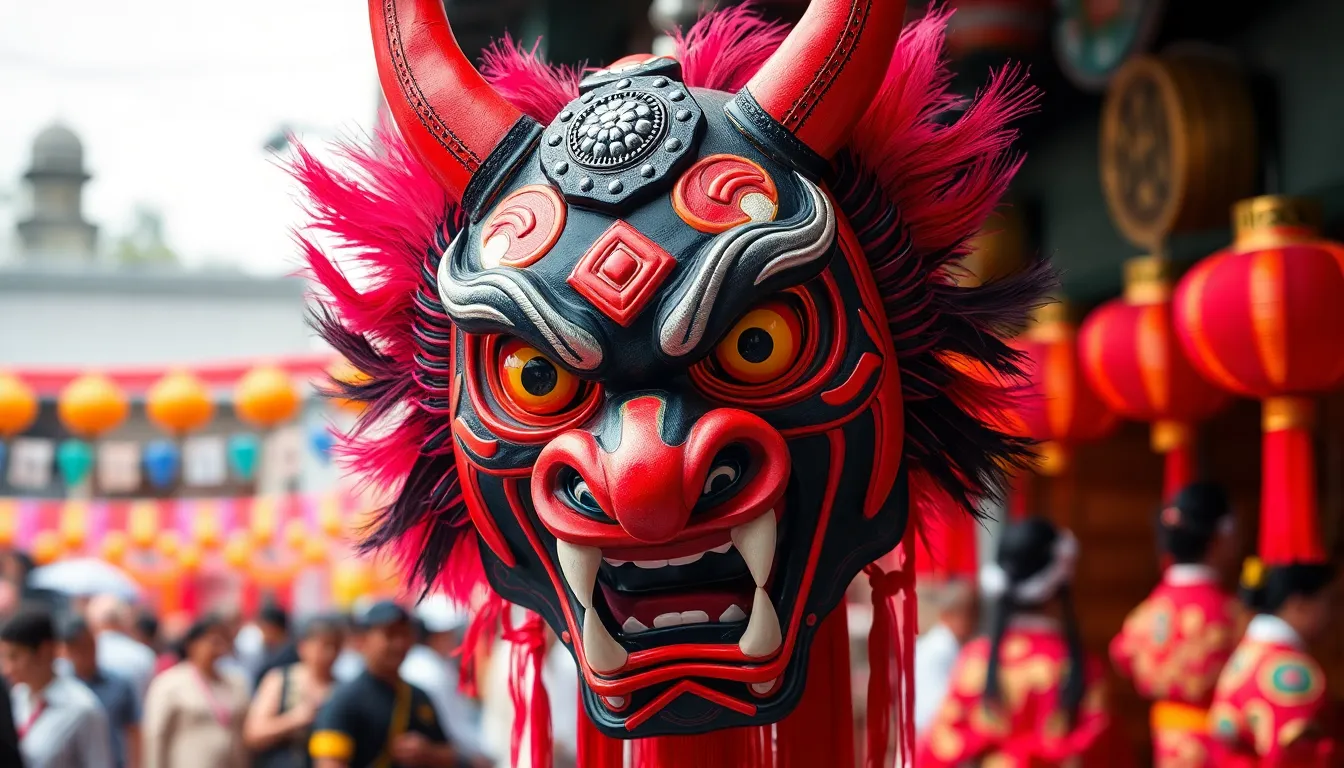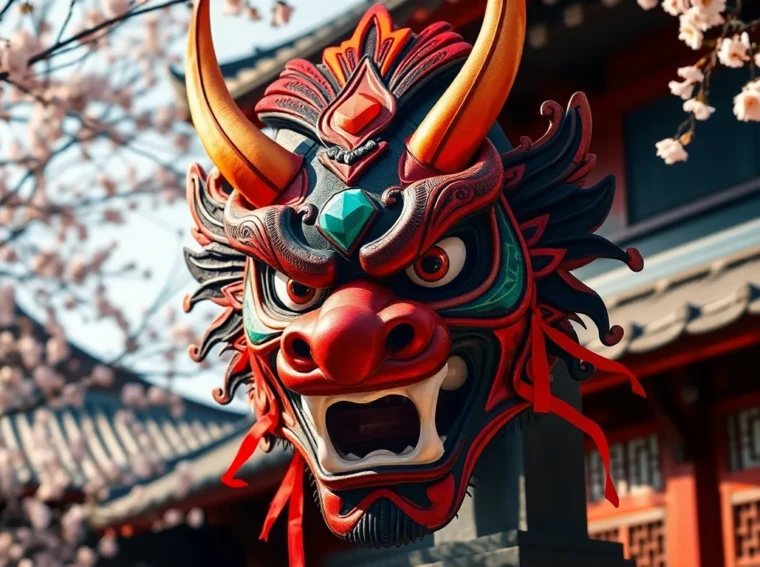The oni face, a striking symbol from Japanese folklore, captivates with its fierce expression and vibrant colors. Often depicted as a horned demon, the oni embodies both chaos and protection, making it a complex figure in cultural narratives. Its bold features and exaggerated expressions have inspired countless artistic interpretations, from traditional masks to modern tattoos.
In contemporary culture, the oni face has transcended its mythological roots, appearing in various forms of media and fashion. This evolution reflects a growing fascination with the supernatural and the allure of the unknown. As people seek to connect with deeper cultural meanings, the oni face stands as a powerful emblem of strength, resilience, and the duality of human nature.
Understanding Oni Face
The oni face is steeped in rich tradition and serves as a potent symbol in Japanese culture. Its diverse representations reflect various aspects of human experiences, emotions, and beliefs.
Origin and Cultural Significance
The oni originated in Japan’s pre-modern history, evolving from ancient deities and spirits. In folklore, the oni often appears as a malevolent figure associated with chaos and mischief. However, some narratives portray omens of protection, warding off evil spirits. This complex duality emphasizes resilience and strength within cultural narratives. Festivals, such as Setsubun, actively utilize oni faces to expel negative forces, showcasing their significance in ritual practices. Their appearances in art, literature, and performance reinforce the oni’s role as both a fearsome adversary and a guardian spirit.
Physical Characteristics
The oni face is easily recognizable due to its distinct features. Prominent elements include sharp horns, fierce expressions, and vibrant, contrasting colors. Typically, the skin tone ranges from deep reds and blues to greens, symbolizing various traits and attributes. Facial attributes often include exaggerated fangs and glaring eyes, which impart a sense of power and intimidation. Masks, crafted for traditional dances and festivals, highlight these characteristics and serve as powerful artistic expressions. The striking visual identity of the oni face resonates within contemporary culture, contributing to its ongoing popularity in various forms of media and personal expression.
The Representation of Oni Face in Art

The oni face appears prominently across various art forms, showcasing its cultural significance. Both traditional and modern representations highlight its dynamic role in Japanese folklore.
Traditional Art Forms
Traditional art forms, such as ukiyo-e prints and Noh theater, feature the oni face prominently. Artists like Katsushika Hokusai and Utagawa Kuniyoshi utilized vivid colors and intricate details to depict oni in a variety of scenes. Masks designed for Noh and Kabuki theater convey the emotional depth of oni characters, emphasizing their fierce expressions and dramatic features. Festivals often incorporate large, decorative masks that represent oni, underscoring their role in rituals aimed at warding off evil spirits. These artistic representations serve not only aesthetic purposes but also reinforce cultural narratives surrounding chaos, protection, and human emotion.
Modern Interpretations
Modern interpretations of the oni face span graphic design, tattoos, and street art. Tattoo artists frequently draw inspiration from the vibrant colors and fierce expressions of traditional oni, adapting these elements into unique personal designs. Graphic designers use oni faces in digital art, integrating them into pop culture and contemporary media. Anime and manga often depict oni face characters in various contexts, from heroic figures to antagonists, reflecting modern audiences’ fascination with duality and complexity. This evolution demonstrates how the oni face transforms while retaining its cultural essence, allowing for diverse expressions of identity and meaning in today’s artistic landscape.
Oni Face in Popular Culture
The oni face appears in various forms of popular culture, showcasing its enduring legacy and adaptability. Its fierce characteristics resonate across multiple mediums, from movies and television to video games.
Movies and Television
Oni faces frequently appear in movies and television, often representing both antagonistic and heroic roles. Films like “The Ring” and “The Grudge” exemplify the horror genre’s use of oni-inspired imagery to evoke fear and intrigue. Animated series, such as “Naruto” and “Demon Slayer,” incorporate oni characters that highlight their duality, showcasing complexity in motivations and emotions. Live-action adaptations of anime also draw on oni themes, reinforcing the symbol’s cultural significance and visual impact. Notably, traditional Japanese folklore eclipses these representations, grounding them in a rich narrative history.
Video Games
Video games leverage the oni face as a powerful icon, integrating it into gameplay and storytelling. Titles like “Okami” and “Ghost of Tsushima” feature oni-inspired visuals and themes, exploring spiritual and mythical elements. Customization options in games allow players to incorporate oni designs into their characters, reflecting personal expression and cultural appreciation. Moreover, the prevalence of oni faces in fighting games, such as “Street Fighter,” emphasizes their fierce nature and iconic status. These representations enhance gameplay aesthetics while celebrating the historical and cultural roots of the oni symbol.
Oni Face
The oni face symbolizes a complex interplay of good and evil in Japanese culture. Its representation varies significantly across different contexts, highlighting the duality of human experiences.
Good vs. Evil
The oni face often embodies the tension between good and evil forces. While traditionally depicted as malevolent beings causing chaos, many stories showcase oni as protectors against malevolent spirits. The prevailing imagery of oni in festivals, such as Setsubun, illustrates this duality. Participants throw soybeans at oni masks to drive away evil while inviting good fortune. This action reflects the cultural belief that confronting evil through symbolic means can restore harmony and balance, reinforcing the notion that good and evil coexist in human experiences.
Protection and Good Fortune
The oni face also represents protection and the granting of good fortune. In various cultural narratives, oni serve as guardians, warding off misfortune and illness. For instance, some families display oni figures at home to invoke protection from malevolent forces. The vibrant colors and fierce expressions of the oni face communicate strength and resilience. This protective symbolism finds expression in talismans and amulets designed for good fortune, showcasing the transformation of the oni from symbols of fear to embodiments of safety and prosperity. Overall, the oni face’s role as a protector highlights its capacity to adapt its meaning within the cultural landscape.
Conclusion
The oni face stands as a captivating symbol in Japanese culture, embodying the intricate balance between chaos and protection. Its striking visual identity continues to inspire artists and storytellers across various mediums, from traditional theater to modern tattoos and graphic design. This enduring emblem reflects a deep cultural narrative that resonates with audiences today.
As it evolves, the oni face remains a testament to the complexities of human emotion and experience. Whether depicted as a fearsome demon or a guardian spirit, its significance endures, reminding us of the multifaceted nature of good and evil. Embracing the oni face allows individuals to connect with a rich cultural heritage while exploring themes of resilience and transformation in their own lives.
